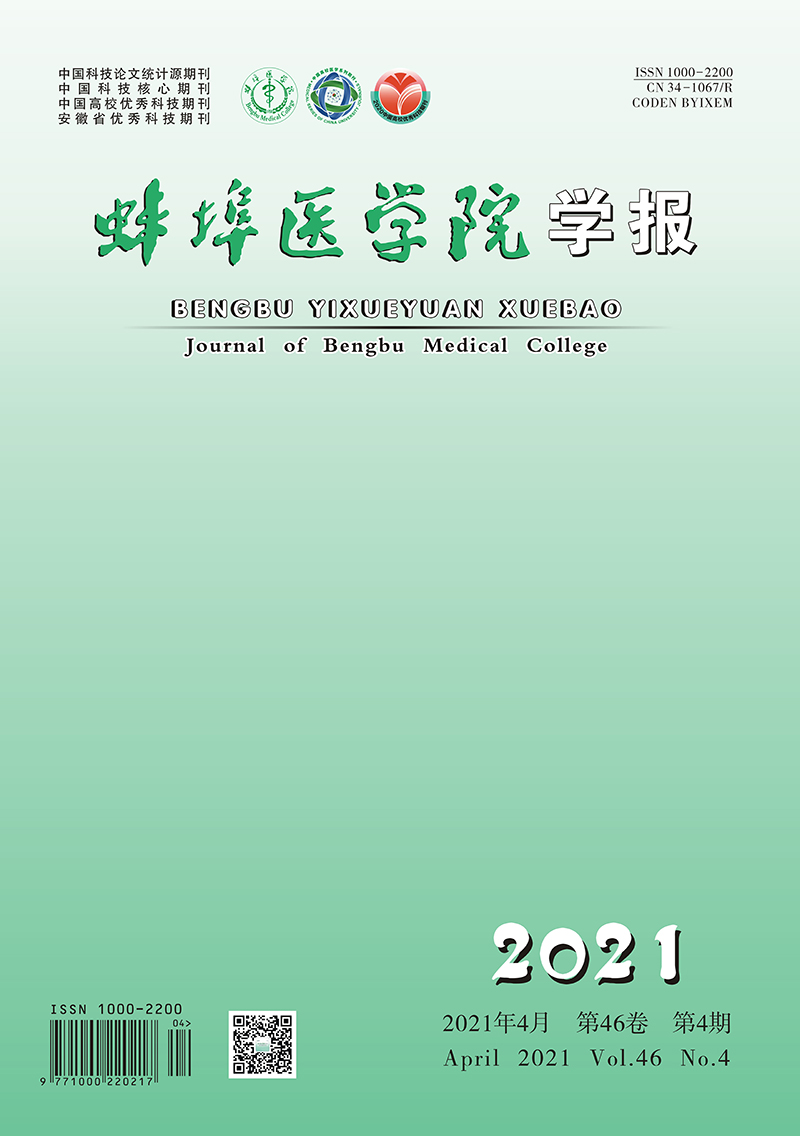-
近年来,胸腔镜手术因具有创伤小、术后恢复快等优点而获得了快速发展。该手术的常规麻醉方式为双腔气管插管全身麻醉,但是双腔气管插管会刺激机体儿茶酚胺分泌释放增加,机体应激反应大;同时,麻醉控制呼吸结束后,残留的神经肌肉麻痹,会引起肺不张等并发症[1],且通气侧肺承受的气道压力要比双肺通气的气道压力更高,因此髙吸气峰压可能会引起肺损伤,不利于病人的快速康复[2-3]。
LMA-Fastrach喉罩属于临床插管型喉罩,其长度较短、管径较大,可通过管径较大的气管导管并建立气道,它的发明解决了通气问题,同时可以迅速引导完成气管插管,安全性非常高。使用LMA-Fastrach喉罩的胸腔镜手术,手术开始后因为术侧胸膜腔负压减少,导致了手术肺逐渐塌陷,能给术者提供良好的暴露术野并且保留病人自主呼吸。另外,术中联合运用相应的神经节阻滞,又可减少手术中镇痛药物的使用,避免术后残留神经肌肉麻痹和肺不张[4],以及可能出现的手术区域神经病理性疼痛,为术后提供良好的镇痛[5],为肺功能恢复创造条件。但是,也有人怀疑喉罩麻醉在胸腔镜手术中造成的医源性气胸引起纵隔摆动和患侧肺塌陷,会影响低氧血症和血流动力学的稳定[6]。本研究在胸腔镜手术麻醉中,采用LMA-Fastrach喉罩联合椎旁神经、星状神经节阻滞,着力于评估LMA-Fastrach喉罩联合椎旁神经、星状神经节阻滞在胸腔镜手术中应用的安全性和有效性,进一步指导未来临床工作。现作报道。
HTML
-
选择2017年4月至2019年4月在我院胸外科住院病人80例,拟行胸腔镜手术(肺大泡、肺外结节病,肺肿瘤楔形切除术)。其中男43例,女37例,ASA分级Ⅰ或Ⅱ级,年龄18~45岁,体质量指数(BMI)18~25 kg/m2,Mallampati分级: Ⅰ~Ⅱ级。排除重大的心、脑、肺、肾等疾病病人。样本量计算:查阅资料得知双腔管手术后病人肺不张发病率为24%,通过预实验我们发现LMA-Fastrach喉罩联合椎旁神经、星状神经节阻滞麻醉肺不张发病率为5%,考虑脱落率为20%,我们的样本量通过公式$N = \frac{{{{({u_\alpha } + {u_\beta })}^2}(1 + 1/\kappa )p(1 - p)}}{{{{({p_e} - {p_c})}^2}}}$计算得出N=80例。由于手术需要腔镜中转开胸手术8例病人,围手术期随访不合作病人7例,最终纳入65例,分别为采用传统双腔管支气管麻醉组(T组)32例和LMA-Fastrach喉罩联合椎旁神经、星状神经节阻滞麻醉组(M组)33例。2组一般情况比较差异均无统计学意义(P>0.05)(见表 1),具有可比性。
分组 男 女 年龄/岁 体质量/kg BMI/(kg/m2) 手术时间/min T组 21 11 28.6±8.5 68.3 ± 8.2 24.1 ± 2.1 86.3±15.8 M组 22 11 28.0±7.6 65.1 ± 7.8 23.6 ± 2.2 84.1±18.2 t 0.27* 0.33 1.79 1.04 0.58 P 0.604 >0.05 >0.05 >0.05 >0.05 *示χ2值 -
病人侧卧于手术床上,进针点为胸腔镜打孔入口同侧节段的椎旁间隙。首先通过超声辅助,显示出与进针点相邻2个椎体的横突,同时找出横突下显现高亮影的胸膜上缘,最后用神经刺激针从所需阻滞点之间的上下两个横突间入路,在胸膜表面显示楔形的低回声区域处注入0.75%罗哌卡因5 mL,即完成椎旁神经阻滞。手术开始前注意观察穿刺区域壁层胸膜下有无血肿,相对应肺组织有无裂伤等。病人再由侧卧改为仰卧,头偏向手术切口对侧,取手术侧胸锁乳突肌后缘与静外静脉交叉处,平第6颈椎横突进针,回抽无血及脑脊液注入局麻药1%利多卡因5 mL。
-
病人术前禁食禁饮8 h,麻醉前30 min肌内注射盐酸戊乙奎醚0.5 mg。病人入室后,右美托咪啶配成4 μg/mL以1 μg/kg速率缓慢静脉泵注10 min。T组:麻醉诱导采用丙泊酚2 mg/kg,舒芬太尼0.3 μg/kg,顺苯磺酸阿曲库铵0.2 mg/kg,采用传统的双腔管支气管插管麻醉。M组:麻醉诱导采用丙泊酚2 mg/kg,舒芬太尼0.3 μg/kg,采用置入LMA-Fastrach喉罩,成功后采用纤支镜和/或听诊确定插管是否成功。所有病人除了常规生命体征检测外,均行右侧桡动脉穿刺置管测压及BIS监测。
-
T组:诱导后以瑞芬太尼0.5~1.0 μg·kg-1·min-1、丙泊酚8~12 mg·kg-1·h-1、阿曲库胺5~10 μg·kg-1·min-1和右美托咪定0.5~1.0 μg·kg-1·min-1进行维持。手术开始后单肺通气,潮气量设置7 mL/kg,呼吸频率16次/分。通过调整药物输注速度使BIS值基本维持在45~55。镇痛效果欠佳时,单次静推注舒芬太尼5 μg挽救。M组:插入喉罩后,外科医生进胸后,术中可见患侧肺逐渐萎陷,萎陷不佳时可器械辅助挤压肺叶。术中丙泊酚8~12 mg·kg-1·h-1、瑞芬太尼0.03~0.05 μg·kg-1·min-1和右美托咪定0.5~1.0 μg·kg-1·h-1进行维持,通过调整药物输注速度使BIS值基本维持在45~55。保留自主呼吸,维持呼吸频率8~10次/分,当呼气末CO2分压>70 mmHg时,手控呼吸以排出CO2。镇痛效果欠佳时,单次静推舒芬太尼5 μg挽救。
-
观察记录2组术后咽痛、声音嘶哑、肺不张发生率;病人插管后(T0)、手术开始后10 min(T1)、手术开始后30 min(T2)、手术结束前10 min(T3)的动脉血气、气道压;术中麻醉药使用总剂量、拔管时间、恢复室停留时间;术后2 h(T4)、24 h(T5)、48 h(T6)时VAS评分、睡眠质量(匹兹堡睡眠质量条目6评分,很好记0分,较好记1分,较差记2分,很差记3分),以及炎症因子含量。
-
采用t检验、χ2检验。
1.1. 一般资料
1.2. 麻醉方法
1.2.1. LMA-Fastrach喉罩联合超声引导下椎旁神经、星状神经节阻滞麻醉方法
1.2.2. 麻醉诱导插管
1.2.3. 麻醉维持
1.3. 监测方法
1.4. 统计学方法
-
2组病人咽痛、声音嘶哑、肺不张发生率比较差异均无统计学意义(P>0.05)(见表 2)。
分组 n 咽痛 声音嘶哑 肺不张 T组 32 6 2 5 M组 33 1 0 1 校正χ2 — 2.50 0.51 1.62 P — >0.05 >0.05 >0.05 -
T组围手术期瑞芬太尼、舒芬太尼使用量、气管拔管时间、恢复室停留时间均高于M组,差异有统计学意义(P < 0.01)(见表 3)。
分组 n 瑞芬太尼/mg 舒芬太尼/μg 拔管时间/min 恢复室停留时/min T组 32 0.5±0.1 30.3±3.7 24.2±5.8 37.9±5.0 M组 33 0.2±0.5 20.5±3.5 15.0±3.9 25.7±4.2 t — 3.72* 12.17 8.33* 11.82 P — < 0.01 < 0.01 < 0.01 < 0.01 *示t′值 -
T4时间点T组镇痛评分及各炎症因子均高于M组(P < 0.01);T5时间点T组镇痛评分、睡眠质量评分及各炎症因子均高于M组(P < 0.01);T6时间点T组镇痛评分和睡眠质量评分高于M组(P < 0.01和P < 0.05)(见表 4)。
分组 n 镇痛评分/分 睡眠质量/分 IL-1β/(pg/mg) TNF-α/(pg/mg) T4 T组 32 4.6±0.6 — 630.9±26.4 330.9±26.4 M组 33 3.1±0.4 — 589.4±30.3 284.9±24.8 t — 13.16* — 6.53 8.03 P — < 0.01 — < 0.01 < 0.01 T5 T组 32 3.4±0.5 1.6±0.5 574.8±19.2 274.8±19.2 M组 33 2.2±0.4 1.1±0.4 527.2±15.6 227.2±15.6 t — 11.85 4.94 12.17 12.17 P — < 0.01 < 0.01 < 0.01 < 0.01 T6 T组 32 2.9±0.6 0.9±0.6 507.7±22.8 207.8±24.7 M组 33 1.4±0.5 0.6±0.6 501.5±31.2 211.4±14.1 t — 12.15 2.24 1.01 0.80 P — < 0.01 < 0.05 >0.05 >0.05 示*t′值 -
T0时间点2组病人血气分析及气道压比较差异无统计学意义(P>0.05);T1时间点2组病人血气分析差异无统计学意义(P>0.05),而T组气道压显著高于M组(P < 0.01);T2时间点T组PaO2和气道压高于M组(P < 0.05和P < 0.01);T3时间点PaO2显著高于M组(P < 0.01)(见表 5)。
分组 n PaCO2/mmHg PaO2/mmHg 气道压/cmH2O T0 T组 32 36.2±2.6 152.6±17.3 17.4±3.6 M组 33 35.8±1.9 155.3±16.5 16.8±3.2 t — 0.79 0.71 0.79 P — >0.05 >0.05 >0.05 T1 T组 32 37.5±2.8 182.4±18.6 26.5±3.8 M组 33 38.2±3.1 176.5±16.2 17.2±3.0 t — 1.06 1.51 12.15 P — >0.05 >0.05 < 0.01 T2 T组 32 38.6±3.0 195.2±17.8 26.8±3.5 M组 33 39.1±3.2 185.6±17.6 17.5±3.1 t — 0.72 2.43 12.58 P — >0.05 < 0.05 < 0.01 T3 T组 32 37.2±2.6 215.2±21.5 17.6±3.4 M组 33 37.6±2.5 200.8±19.8 17.8±3.3 t — 0.70 3.12 0.27 P — >0.05 < 0.01 >0.05
2.1. 2组病人不良反应比较
2.2. 2组病人围手术期麻醉相关指标比较
2.3. 2组病人术后镇痛评分、睡眠质量及炎症因子比较
2.4. 2组病人血气分析及气道压比较
-
胸腔镜手术中采用全身麻醉纤维支气镜插管存在一些潜在的不利的因素,比如双腔管会刺激机体儿茶酚胺分泌,应激反应大。同时,麻醉控制呼吸结束后,残留的神经肌肉麻痹,会引起肺不张等并发症。再者,术中单肺通气引起的高吸气峰压,是引起肺损伤的重要因素[7]。动物实验已经证实,肺泡上皮细胞在气道压达到一定阈值时会发生破裂,肺泡与肺泡毛细血管之间呼吸膜的通透性,也会因气道压剧增而继发引起肺水肿。本研究中,我们发现M组T1~T2时间点气道压低于T组(P < 0.01),与上述理论一致。
LMA-Fastrach喉罩保留自主呼吸下的胸腔镜手术,手术中因为术侧胸膜腔负压减少,导致了手术肺逐渐塌陷,仍然能给术者提供良好的暴露术野。然而,手术中造成的医源性气胸存在其他的一些风险,比如有人认为胸膜腔负压减少,使纵隔向下压迫进一步减少非手术侧肺体积[8]。医源性气胸引起的纵隔摆动有可能会引起血流动力学的改变、低氧血症的发生。但是,轻度至中度高碳酸血症时,机体可以通过增加呼吸频率改善低氧血症[9-10]。本研究中,M组T1~T3的PaCO2与T组相比略有升高,但差异无统计学意义(P>0.05),T2和T3时间点PaO2高于M组(P < 0.05和P < 0.01)。
既往在胸腔镜手术中,手术器械刺激挤压手术切口,容易损伤肋间神经,病人术后疼痛评分增加,急性疼痛发展成术后慢性病理性神经痛的概率高[11-12],且由于过度拉肺实质或肺门手术支气管,会引起内呛咳反应。过去研究者通常采用喉罩辅以胸膜硬膜外麻醉来完善镇痛及预防呛咳反应。但是胸膜硬膜麻醉很容易造成双侧阻滞,同时诱导一定的呼吸肌运动阻滞程度,导致10%左右的肺容积减少[13],同时胸腔硬膜外麻醉会诱导外周血管舒张和功能性血容量不足[14]。近年来,人们研究发现胸椎旁神经阻滞与硬膜外阻滞在镇痛治疗是替代胸部硬膜外的有效替代方案[15-16]。
通过超声可视化引导下行椎旁神经阻滞,可以阻滞该侧三类神经传导通路,包括运动、感觉神经与交感神经传导通路,获得与硬膜外麻醉相类似的效果,虽然椎旁神经阻滞对病人仍然会产生血管扩张反应,但相比于硬膜外的双侧阻滞效果,其对病人呼吸、循环的影响小,既往大量研究将椎旁神经阻滞可以安全用于开胸、乳腺、心脏手术及治疗带状疱疹神经痛等治疗,并取得了满意治疗效果[17-18]。本研究中采用LMA-Fastrach喉罩联合超声引导下椎旁神经、星状神经节阻滞麻醉,T组围手术期瑞芬太尼、舒芬太尼使用量、气管拔管时间、恢复室停留时间均高于M组,差异有统计学意义(P < 0.01)。这些优势不是肋间神经阻滞和硬膜外神经阻滞能完全取代的,肋间神经阻滞只能阻断胸腔镜穿刺部位局部的痛觉及肌紧张状态,作用范围较小,而胸膜硬膜麻醉很容易造成双侧阻滞,引起呼吸抑制和循环抑制。
传统的胸腔镜手术采用双腔气管插管静吸复合麻醉。双腔气管插管会造成机体应激反应大,术毕手术区域伤口疼痛又会加重病人烦躁、焦虑,机体应激反应增加。本研究发现,T4时间点T组镇痛评分及各炎症因子均高于M组(P < 0.01);T5时间点T组镇痛评分、睡眠质量评分及各炎症因子均高于M组(P < 0.01);T6时间点T组镇痛评分和睡眠质量评分高于M组(P < 0.01和P < 0.05)。星状神经节阻滞能阻断脊髓反射通路,降低交感神经兴奋性[19],稳定手术引起的机体应激反应[20-21]。






 DownLoad:
DownLoad: